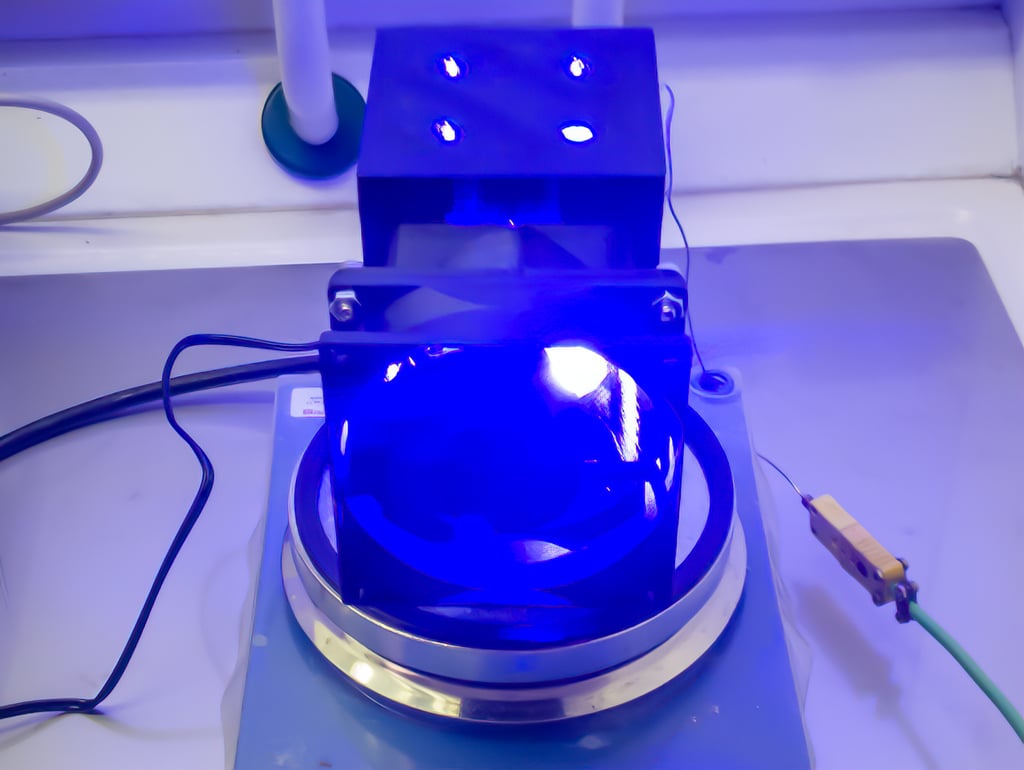
Photoreactor
thingiverse
This is a photoreactor with four high power LEDs that was designed for visible light applications, in particular photoredox chemistry. It fits a standard magnetic stirplate and can accomodate up to four 20 mL screw neck vials simultaneously. Designed to be inexpensive, easy to print and assemble, it can be built from readily available components for EUR 100 or less. *Update March 10, 2020* The lid has been updated with slightly thicker clips. They tended to break in the original design. I'd also like to mention that I used [Labsolute ND24 vials, 57 x 27.5 mm](https://www.labsolute-chemsolute.com/en/products/product/itemnumber/7612150/) with screw caps with septa to design this. I printed and tested this with four 10 W blue LEDs (450 nm wavelength) but other types and wavelengths should work too. Using the 10 W LEDs shown here, an 80 mm fan must be used with the fan duct in order to avoid heating the reaction vials above 30 degrees C. If lower power LEDs are used it may be possible to use a 60 mm fan mounted directly to the photoreactor without the fan duct. With the 10 W LEDs used here, a 60 mm fan lead to temperatures above 40 degrees C in the reaction vials. **CAUTION!** These LEDs are extremely bright and there is significant stray light from the various vents and fans. Take precautions to avoid looking directly at the LEDs as this may cause eye damage. An opaque shield must be used around the reactor when the light is on. I strongly discourage using this design with invisible ultraviolet light! This device is intended for use in a chemistry laboratory by qualified and trained personnel. Eye damage and even blindness can result from improper use. This is not a toy! *Bill of materials* 4 high power LEDs (up to 10 W each) [link](https://www.ebay.com/itm/372736627306) 4 power resistors 2.2 Ohm 5 W [link](https://www.elextra.dk/details/H13309/effektmodstand-5w-22-ohm-5) 1 fan 70 x 70 x 15 mm (12 V) [link](https://elektronik-lavpris.dk/p136159/de07015b12u-ventilator-70x70x15mm-12vdc/) 1 heatsink 68 x 68 x 9 mm [link](https://elektronik-lavpris.dk/p125304/ick-pga-27x27-heatsink-68x68x9mm/) 4 M4 x 40 mm pan head machine screws 1 power supply 12 V minimum 60 W or 5 A [link](https://www.harald-nyborg.dk/produkt/stroemforsyning-12v-60w-led) 1 DC connector to fit power supply, typically 5.5 x 2.1 mm [link](https://www.elextra.dk/details/H20612/dc-fatning-55-x-21mm-til-kabinet-loddeflige) Wiring, solder and [thermal glue](https://www.coolerkit.dk/shop/phobya-2-component-thermal-139820p.html) as needed *If using a 80 mm fan (recommended):* 1 fan 80 x 80 x 25 mm (12 V) [link](https://elektronik-lavpris.dk/p125220/ee80251s3-999-fan-12v-80x25-s-56m-h-28dba/) 8 M4 x 12 mm socket head machine screws 12 M4 nuts *If using a 60 mm fan (not recommended for 10 W LEDs):* 1 fan 60 x 60 x 15 mm (12 V) [link](https://elektronik-lavpris.dk/p111860/n-cmp-fan22-ventilator-60x60x15mm-3-wire-sensor/) 4 M4 x 25 mm pan head machine screws 8 M4 nuts *Electronics* LEDs need a constant current supply. This is solved here by using a constant voltage 12 V power supply and a series resistor for each LED. The value of the resistor must be selected to achieve the desired current. Here I use LEDs with a 10 V forward voltage drop and a maximum forward current of 1050 mA. Using a 12 V supply and a 2.2 Ohm resistor, Ohm's law tells us that the current will be (12 - 10)/2.2 = 0.909 A = 909 mA. This leaves a bit of safety margin to accomodate minor variations in the supply voltage and the LED forward voltage. The power rating of the resistors is also important. Assuming 0.909 A current and 2 V drop over the resistor, it will need to dissipate 2 x 0.909 = 1.818 W. I selected a 5 W resistor here to give a big safety margin, and I mounted the resistors in the airflow from the cooling fan for extra cooling. If you want to use LEDs with other specifications you will need to select suitable resistors according to the calculations above.
With this file you will be able to print Photoreactor with your 3D printer. Click on the button and save the file on your computer to work, edit or customize your design. You can also find more 3D designs for printers on Photoreactor.
